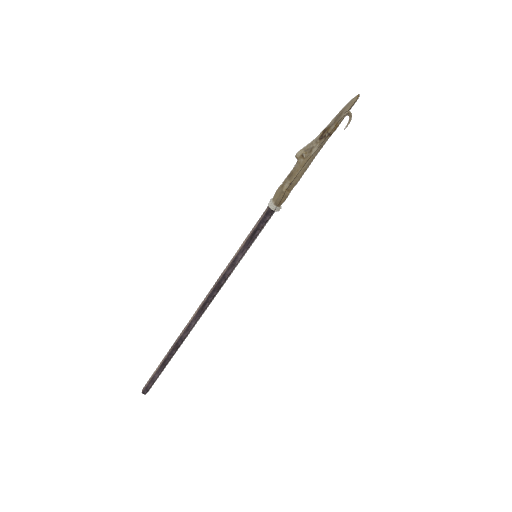Spear
Mi’kmaq: nigog
This spear, dart or harpoon, is made up of a bone point with a curved hook attached to a wooden shaft with plant material. In hunter-gatherer societies, animal bones are collected during the hunt. They are then carved to make different objects, such as tools or ornaments.
This spear can be used for sturgeon, trout, or salmon fishing, generally in shallow water. The fisher, equipped with a spear, waits for the fish to approach before striking with the weapon. The same technique is used for ice fishing.
The spear is also used for eel fishing. This species of fish, abundant in the waters of the St. Lawrence estuary, is very valued by Indigenous peoples. It is through their detailed knowledge of the animal’s behaviour that the Indigenous peoples plan their hunt. They know that eels migrate along the river: it is born and breeds in salt water (in the Sargasso Sea) but spends the rest of its life in freshwater, notably in Quebec and Ontario lakes and rivers. The eel, appreciated for its fatty flesh, is eaten fresh, smoked or dried. Its skin, very resistant, is used to make ornaments like ribbons.
References
Date: Circa 1000
Origin: United-States
Owner: Vieux moulin—Hydromellerie et miellerie. “Musée de la Neufve-France” private collection. Sainte-Flavie.
Sources:
Digital Museums Canada. (n.d.). Eel fishing in the Côte-du-Sud region. Musée de la mémoire vivante. Retrieved September 22, 2022, from https://www.communitystories.ca/v2/la-peche-a-l-anguille_eel-fishing/story/aboriginal-and-european-techniques/
Laberge, M. (1996). Création d’une nouvelle iconographie sur les algonquiens du Nord-Est de l’Amérique à partir de données ethno-historiques datant d’avant 1760 [The creation of a new iconography of the Algonquians of North-East America using pre-1760 ethno-historical data] [Doctoral dissertation, Université Laval]. CorpusUL. https://corpus.ulaval.ca/bitstreams/ad9a212e-0edb-496f-abf3-1ab25c05f6b3/download
Gouvernement du Québec. (n.d.). La pêche à l’anguille [Eel fishing]. Répertoire du patrimoine culturel du Québec. Retrieved September 22, 2022, from https://www.patrimoine-culturel.gouv.qc.ca/detail.do?methode=consulter&id=78&type=imma
